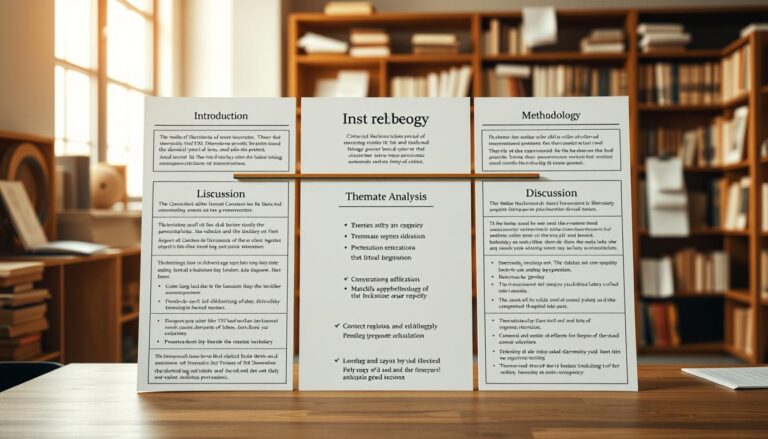Crafting a thesis that meets the rigorous standards of Australian universities can be a daunting task. A well-structured thesis is crucial for academic success, and understanding its key components is essential.
Expert Assignment Help offers a thesis writing service that guides students through the process, ensuring their work is of high quality and adheres to the academic structure Australia demands. With a panel of industry experts and PhD holders, they provide invaluable assistance on how to write a thesis that stands out.
By leveraging their expertise, students can produce a thesis that not only meets but exceeds expectations.
Key Takeaways
- Understanding the structure of a thesis is vital for academic success.
- Expert Assignment Help provides a comprehensive thesis writing service.
- A well-structured thesis adheres to the academic standards of Australian universities.
- Industry experts and PhD holders assist students in crafting a high-quality thesis.
- Knowing how to write a thesis effectively is crucial for achieving academic excellence.
The Significance of a Well-Structured Thesis in Australian Academia
In Australian universities, the significance of a well-structured thesis cannot be overstated. A well-organized thesis not only enhances the clarity of the research but also demonstrates the researcher’s ability to communicate complex ideas effectively.
Why Structure Matters in Academic Assessment
A well-structured thesis is crucial for academic assessment as it allows examiners to follow the researcher’s argument logically. A clear structure helps in presenting the research in a coherent manner, making it easier for assessors to evaluate the work based on its academic merit.
How Australian Universities Evaluate Theses
Australian universities evaluate theses based on several criteria, including the clarity of the research question, the effectiveness of the literature review, and the coherence of the argument. For instance, The University of Sydney has specific guidelines that emphasize the importance of a well-structured thesis. Notably, it does not allow a thesis by publication, underscoring the value placed on a cohesive, structured research document.
Understanding Thesis Writing Services in Australia
Thesis writing services in Australia have become a vital resource for students seeking to produce high-quality academic work. These services are designed to support students through the challenging process of researching and writing a thesis.
What Professional Thesis Writing Services Offer
Professional thesis writing services, such as OZessay, provide custom thesis writing assistance to ease the pressure on students. Their team of expert writers has actual research experience and holds PhDs or MAs from top Australian colleges. These services offer a range of benefits, including custom research, writing, and editing to ensure that the final product meets the highest academic standards.
How to Choose a Reputable Service
When selecting a thesis writing service, it’s crucial to choose a reputable provider. Look for services with a proven track record, positive customer reviews, and a team of qualified writers. A reputable service will also offer plagiarism-free work and adhere to strict confidentiality guidelines.
Typical Costs and Timeframes
The costs and timeframes associated with thesis writing services can vary significantly. Factors influencing cost include the complexity of the project, the level of study, and the deadline. A detailed breakdown of typical costs and delivery times is as follows:
| Service Level | Typical Cost | Delivery Timeframe |
|---|---|---|
| Undergraduate Thesis | $1,500 – $3,000 | 4-6 weeks |
| Postgraduate Thesis | $3,000 – $6,000 | 6-12 weeks |
| PhD Thesis | $6,000 – $10,000+ | 12-20 weeks |
By understanding what thesis writing services offer, how to choose a reputable service, and the associated costs and timeframes, students can make informed decisions about seeking professional assistance with their theses.
Key Components of a Strong Thesis Document
Understanding the components of a well-structured thesis is essential for academic success. A strong thesis document is composed of several key elements, each serving a unique purpose in the overall structure.
Title Page and Preliminary Pages
The title page is the first impression of your thesis, providing crucial information such as the title, your name, and the institution. The preliminary pages include the acknowledgments, table of contents, and lists of figures and tables. These pages are essential for setting the tone and providing context to your research.
Abstract and Executive Summary
The abstract is a concise summary of your research, highlighting the main points, methodology, and conclusions. It is crucial for readers to quickly understand the essence of your thesis. An executive summary, while similar, provides a more detailed overview, often used in professional and business theses.

Table of Contents and Lists
A well-organized table of contents is vital for navigation, allowing readers to locate specific sections easily. Lists of figures and tables provide a quick reference to the visual elements within your thesis, enhancing clarity and readability.
Appendices and Supplementary Materials
Appendices contain supplementary materials that support your research but are not essential for understanding the main body of your thesis. These can include raw data, extra figures, or detailed descriptions of methodologies.
| Component | Purpose |
|---|---|
| Title Page | Provides initial information about the thesis |
| Abstract | Concise summary of the research |
| Table of Contents | Facilitates navigation through the thesis |
| Appendices | Contains supplementary materials |
Crafting an Effective Thesis Statement
Crafting an effective thesis statement is a pivotal step in the thesis writing process, as it sets the tone for the entire document. A well-structured thesis statement not only guides the reader through the thesis but also provides a clear direction for the writer.
Characteristics of a Strong Thesis Statement
A strong thesis statement is clear, concise, and arguable. It should provide a specific claim or argument that is supported by evidence throughout the thesis. Additionally, a good thesis statement is focused and avoids vague or overly broad statements.
Examples of Successful Thesis Statements
Successful thesis statements are those that effectively encapsulate the main argument of the thesis. For instance, in a thesis on climate change, a strong thesis statement might be: “This thesis examines the impact of climate change on coastal communities, arguing that immediate action is necessary to mitigate its effects.”
Common Pitfalls to Avoid
When crafting a thesis statement, it’s essential to avoid common pitfalls such as being too vague or overly ambitious. A thesis statement that is too broad can lead to a lack of focus in the thesis. It’s also crucial to avoid statements that are too obvious or lack an arguable claim.
By understanding the characteristics of a strong thesis statement, examining examples, and avoiding common pitfalls, students can craft a thesis statement that effectively guides their research and writing.
The Standard Structure of an Australian Academic Thesis
The structure of an Australian academic thesis varies depending on the level of study and the discipline, making it essential to understand these differences. A thesis is a significant academic undertaking that requires a clear and logical structure to effectively communicate research findings.
Differences Between Undergraduate and Postgraduate Theses
Undergraduate theses typically require a more straightforward structure, focusing on demonstrating a student’s understanding of the subject matter. In contrast, postgraduate theses, such as those at the master’s or doctoral level, demand a more complex and original contribution to the field. Postgraduate theses often involve more rigorous research methodologies and a deeper analysis of the research topic.
Discipline-Specific Variations
The structure of a thesis can also vary significantly across different disciplines. For instance, a thesis in the humanities may have a different structure compared to one in the sciences or engineering. Understanding these discipline-specific variations is crucial for producing a thesis that meets the expectations of the academic community.
Australian Academic Conventions
Australian universities generally follow international standards for thesis structure, with some specific requirements that may vary between institutions. It is essential for students to familiarize themselves with these conventions to ensure their thesis is formatted correctly and meets the necessary academic standards.
In conclusion, the structure of an Australian academic thesis is influenced by several factors, including the level of study and the discipline. By understanding these factors, students can produce a well-structured thesis that effectively communicates their research findings.
Literature Review: Building the Foundation
Building a strong foundation for your thesis requires a thorough literature review that synthesizes existing knowledge and identifies gaps in current research. A literature review is not merely a summary of existing studies; it’s a critical analysis that contextualizes your research within the broader academic discourse.
Conducting Comprehensive Research
To conduct comprehensive research, you must employ a systematic approach to searching and selecting relevant literature. This involves using a variety of databases, academic journals, and other credible sources to gather a wide range of perspectives on your research topic. Effective search strategies include using specific keywords, Boolean operators, and filters to refine your search results.

Synthesising and Critiquing Existing Knowledge
Synthesising existing knowledge involves integrating the findings of previous studies to create a cohesive narrative. This requires critical thinking to evaluate the methodologies, results, and conclusions of existing research. By critiquing existing knowledge, you can identify patterns, debates, and contradictions in the literature, which helps to contextualize your study.
Identifying Research Gaps
A crucial aspect of a literature review is identifying research gaps that your study can address. This involves analyzing the limitations of existing research and determining how your study can contribute to the field. By highlighting these gaps, you can justify the significance of your research and demonstrate its potential to advance current knowledge.
Research Methodology: Approaches in Australian Academic Context
The choice of research methodology is a critical decision for researchers in Australia, impacting the success of their academic pursuits. In the Australian academic context, research methodology is not just about choosing between qualitative and quantitative methods; it’s about aligning the methodology with the research question and objectives.
Qualitative vs Quantitative Methods
Qualitative research methods are used to gain an in-depth understanding of a research problem or issue. They involve collecting and analyzing non-numerical data (e.g., text, voice, or images) to explore concepts and experiences. In contrast, quantitative methods involve numerical data and are often used to test hypotheses or predict outcomes. Australian researchers often choose between these methods based on their research goals.
For instance, a study examining the impact of cultural factors on consumer behavior might employ qualitative methods through interviews or focus groups, while a study analyzing the effect of a new policy on economic growth might use quantitative methods.
Mixed Methods Approaches
Mixed methods research combines both qualitative and quantitative approaches, offering a more comprehensive understanding of the research problem. This approach is increasingly popular in Australian academia as it allows for both the exploration of complex issues and the quantification of trends.
For example, a researcher might use qualitative methods to explore the experiences of participants and then use quantitative methods to validate the findings across a larger population. Resources such as those provided by the University of Technology Sydney offer valuable insights into adapting research methodologies, including mixed methods approaches.
Justifying Your Methodological Choices
Justifying the chosen research methodology is crucial for the credibility and validity of the research. Researchers must clearly articulate why their chosen methodology is appropriate for their research question and how it aligns with their overall research objectives.
This involves discussing the strengths and limitations of the chosen methodology and demonstrating an understanding of alternative approaches. A well-justified methodology enhances the rigor of the research and contributes to its overall quality.
| Methodology | Description | Application |
|---|---|---|
| Qualitative | Involves non-numerical data to explore concepts and experiences. | Understanding consumer behavior, exploring social phenomena. |
| Quantitative | Involves numerical data to test hypotheses or predict outcomes. | Analyzing economic trends, testing the effectiveness of a new drug. |
| Mixed Methods | Combines qualitative and quantitative approaches. | Validating qualitative findings across a larger population, exploring complex social issues. |
Results and Analysis: Presenting Your Findings
The results and analysis section of a thesis is where your research comes alive, providing a clear and concise overview of your findings. Effective presentation of your results is crucial for conveying the significance and impact of your research.
Data Presentation Techniques
Choosing the right data presentation techniques is vital for making your results understandable and engaging. Tables, charts, and graphs are commonly used to display complex data in a visually appealing manner. For instance, using a bar chart to compare categorical data or a line graph to show trends over time can be highly effective.
Analytical Frameworks
An analytical framework provides a structure for interpreting your results. It involves identifying patterns, themes, and correlations within your data. By applying theoretical models or conceptual frameworks relevant to your field, you can contextualize your findings and draw meaningful conclusions.
Visual Representation of Results
Visual representation is a powerful tool for communicating complex information. Using infographics, diagrams, and visual aids can help to simplify your data and make it more accessible to your audience. It’s essential to ensure that your visual representations are clear, well-labelled, and directly relevant to your research questions.
By combining effective data presentation techniques, robust analytical frameworks, and clear visual representation, you can present your findings in a compelling and impactful way.
Discussion: Interpreting Your Research
A well-crafted discussion section is essential for connecting research results to broader implications. This section requires careful interpretation of research findings and a clear connection to the research questions posed at the outset.
Connecting Results to Research Questions
To effectively discuss your research, you must link your findings back to the original research questions. This involves analysing the data collected and determining how it addresses the questions or hypotheses. It’s crucial to be clear and concise, avoiding unnecessary jargon.
Addressing Limitations
No research is without its limitations. Acknowledging these limitations demonstrates a thorough understanding of your research’s scope and potential biases. This section should discuss the implications of these limitations on your findings.
Implications for Theory and Practice
The discussion should also explore the broader implications of your research for both theory and practice. This involves considering how your findings contribute to existing knowledge and their potential applications in real-world contexts.
The Thesis Writing Process: From Proposal to Submission
The thesis writing process is a rigorous academic endeavor that necessitates a well-structured approach from the outset. This process involves several critical stages, from developing an initial proposal to the final submission of the thesis.
Effective thesis writing requires careful planning, including the creation of a realistic timeline and the management of supervisor relationships. For students seeking thesis writing help, understanding these elements is crucial.
Creating a Realistic Timeline
Developing a realistic timeline is essential for managing the thesis writing process efficiently. This involves breaking down the writing process into manageable tasks and allocating sufficient time for each stage.
| Stage | Timeline | Milestones |
|---|---|---|
| Proposal Development | 2 weeks | Draft proposal submission |
| Literature Review | 4 weeks | Completed literature review |
| Data Collection and Analysis | 8 weeks | Data analysis completion |
Managing Supervisor Relationships
Building a positive and productive relationship with your supervisor is vital. Regular meetings and clear communication can help ensure that your thesis is on track and meets the required standards.
Handling Revisions and Feedback
Receiving and incorporating feedback is a critical part of the thesis writing process. Being open to revisions and using feedback to improve your work is essential for producing a high-quality thesis.
By understanding and effectively managing these aspects of the thesis writing process, students can enhance their chances of success. For additional support, resources such as thesis writing help services can provide valuable guidance.
How Professional Thesis Writing Service in Australia Can Elevate Your Work
Professional thesis writing services in Australia offer a range of benefits that can elevate your thesis to the next level. By leveraging the expertise of these services, students can significantly improve the quality and presentation of their academic work.
Editing and Proofreading Support
One of the key advantages of using a professional thesis writing service is the editing and proofreading support they provide. Experienced editors review your thesis for grammatical errors, punctuation, and spelling mistakes, ensuring that your document is polished and error-free.
Structural and Content Guidance
A professional thesis writing service also offers structural and content guidance. This includes assistance with organizing your thesis in a logical and coherent manner, as well as suggestions for improving the clarity and flow of your arguments. Content experts can help you strengthen your thesis statement and ensure that your literature review is comprehensive and well-integrated.
Formatting and Citation Assistance
Formatting and citation are crucial aspects of thesis preparation. A professional thesis writing service can help you navigate the complexities of different citation styles (e.g., APA, MLA, Chicago) and ensure that your thesis is formatted according to the requirements of your institution. This includes assistance with creating a consistent and accurate bibliography.
Language Refinement for Non-Native English Speakers
For non-native English speakers, a professional thesis writing service can provide valuable language refinement support. This includes help with improving sentence structure, vocabulary, and overall language clarity, ensuring that your thesis is not only academically sound but also linguistically precise.
| Service | Description | Benefits |
|---|---|---|
| Editing and Proofreading | Reviewing for grammatical errors and improving clarity | Polished and error-free document |
| Structural and Content Guidance | Assistance with organization and argument flow | Improved coherence and strength of arguments |
| Formatting and Citation | Help with citation styles and formatting requirements | Consistent and accurate bibliography |
Conclusion: Crafting a Thesis That Stands Out in Australian Academia
Crafting a thesis that stands out in Australian academia requires careful planning, effective research, and clear writing. As highlighted throughout this article, a strong thesis is built on a well-structured foundation, a clear thesis statement, and a comprehensive literature review.
To achieve academic success, it’s essential to understand the significance of a well-structured thesis and how Australian universities evaluate them. By leveraging professional thesis writing services in Australia, students can elevate their work and produce a high-quality thesis that meets academic standards.
Ultimately, a standout thesis in Australian academia is one that demonstrates a deep understanding of the research topic, is well-organized, and is written in a clear and concise manner. By following the guidelines outlined in this article, students can produce a thesis that showcases their academic abilities and contributes meaningfully to their field of study.





